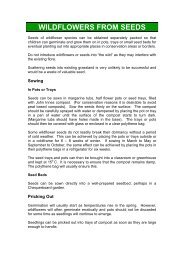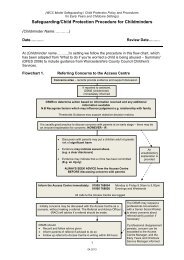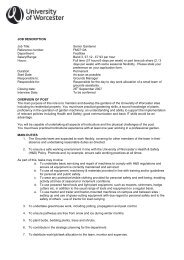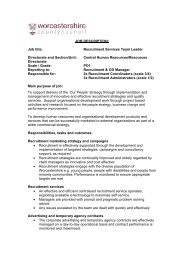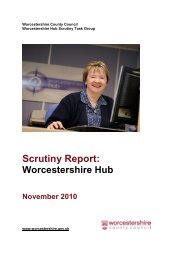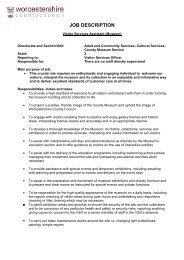Planning for Renewable Energy in Worcestershire Research Paper
Planning for Renewable Energy in Worcestershire Research Paper
Planning for Renewable Energy in Worcestershire Research Paper
You also want an ePaper? Increase the reach of your titles
YUMPU automatically turns print PDFs into web optimized ePapers that Google loves.
Ground/Water/Air Source HeatPumpsGround source heat pumps (GSHP)extract the heat energy storedunderground and use it to contribute toheat<strong>in</strong>g water, either through directlycirculat<strong>in</strong>g water underground, or throughcirculat<strong>in</strong>g an <strong>in</strong>termediary fluid. A suitablearea of land adjacent to the build<strong>in</strong>g isrequired <strong>in</strong> which the pipework can beburied. This can be done eitherhorizontally (<strong>in</strong> which case a large landarea will be needed), or vertically <strong>in</strong> adeep bore (depth of 15m-150m), whichcan be more expensive. One of thepr<strong>in</strong>cipal benefits of the systems is thatthey do not require any externalconditions (e.g. strong direct sunlight) <strong>in</strong>order to work efficiently. Due to thenear-constant temperature of the earth(c.10-12oC) at a depth of around 2m, thesystem can be used all year round,although it is unlikely to produce sufficientoutput to be the sole source of heat,especially dur<strong>in</strong>g the w<strong>in</strong>ter. Typical costs<strong>for</strong> a horizontal system are £800 - £900per kW; <strong>for</strong> a vertical system, costs maybe <strong>in</strong> the region of £1000 - £1500 per kWAs a technology that requires excavations(either vertical or horizontal), there existsa risk with GSHP that archaeologicalrema<strong>in</strong>s could be disturbed or destroyeddur<strong>in</strong>g <strong>in</strong>stallation/ma<strong>in</strong>tenance. The<strong>in</strong>stallation of GSHP is be<strong>in</strong>g <strong>in</strong>cluded ashouseholder permitted development,mean<strong>in</strong>g that plann<strong>in</strong>g permission wouldnot be needed, which could consequentlyreduce the likelihood of proposals be<strong>in</strong>greferred to archaeological officers <strong>for</strong>advice. It is there<strong>for</strong>e suggested thathouseholders choos<strong>in</strong>g to <strong>in</strong>stall a GSHPsystem take reasonable care that therewill be no adverse archaeological impactsaris<strong>in</strong>g from the <strong>in</strong>stallation. If <strong>in</strong> anydoubt, consultation with professionaladvisors is recommended.Water-source heat pumps employ asimilar pr<strong>in</strong>ciple to ground-source, butextract the heat energy from a body ofwater <strong>in</strong>stead of from the ground. Thismethod is unlikely to deliver significantreturns County-wide, as it depends on asuitable body of water (such as a lake)be<strong>in</strong>g <strong>in</strong> close proximity to the build<strong>in</strong>gus<strong>in</strong>g the heat. Water-source systems arealso less efficient dur<strong>in</strong>g w<strong>in</strong>ter months(susceptible to freez<strong>in</strong>g, etc).Air-source heat pumps extract heatenergy from the air outside a build<strong>in</strong>g andtransfer it to be used as space heat<strong>in</strong>g<strong>in</strong>side. The air temperature <strong>in</strong> the WestMidlands is probably <strong>in</strong>sufficient toprovide any major heat<strong>in</strong>g ga<strong>in</strong>s, but thesystem also allows cool air to becirculated <strong>in</strong>side a build<strong>in</strong>g, which canprovide a more susta<strong>in</strong>able alternative toair-condition<strong>in</strong>g.Ground, water and air-source heat pumpsall rely on a small <strong>in</strong>put of energy topower the pump<strong>in</strong>g mechanism. The'coefficient of per<strong>for</strong>mance' determ<strong>in</strong>esthe relationship between the energyrequired to be <strong>in</strong>put, and the energy ga<strong>in</strong>sfrom the system. For ground source, thisequates to a ratio of approximately 3-4units of heat energy received <strong>for</strong> everys<strong>in</strong>gle unit of energy to run the system.Air-source pumps are less efficient.GeothermalGeothermal heat is extracted from theearth to provide direct heat energy, <strong>in</strong> the<strong>for</strong>m of hot spr<strong>in</strong>gs, etc. However, it isunlikely that this will be a suitable methodof energy generation <strong>in</strong> the County, as thetemperatures below the earth are too low.Accord<strong>in</strong>g to the Halcrow study, "…thegeological structure of the region is suchthat temperatures are not sufficientlyelevated near to the surface to allow theuse of geothermal heat".APPENDIX A ● <strong>Plann<strong>in</strong>g</strong> <strong>for</strong> <strong>Renewable</strong> <strong>Energy</strong> <strong>in</strong> <strong>Worcestershire</strong>Technical <strong>Research</strong> <strong>Paper</strong> 41



